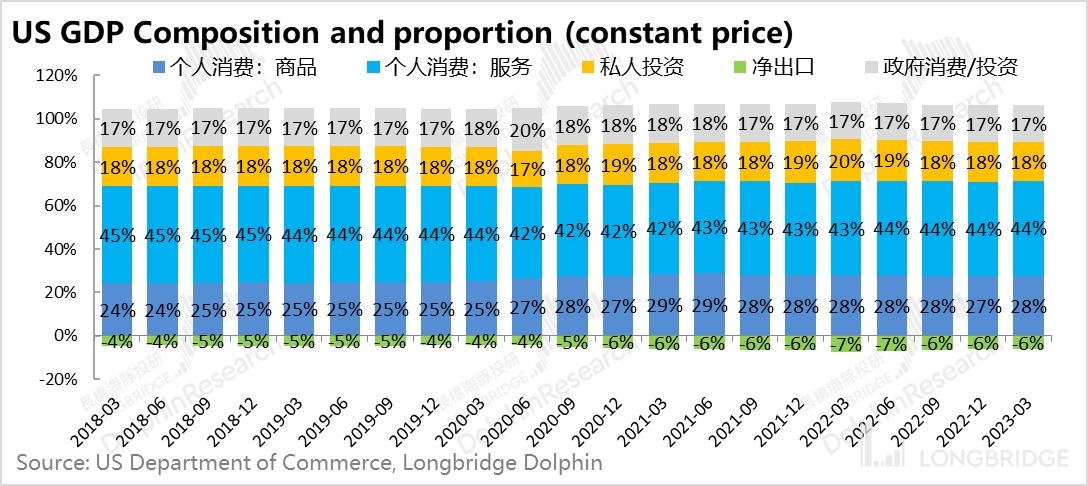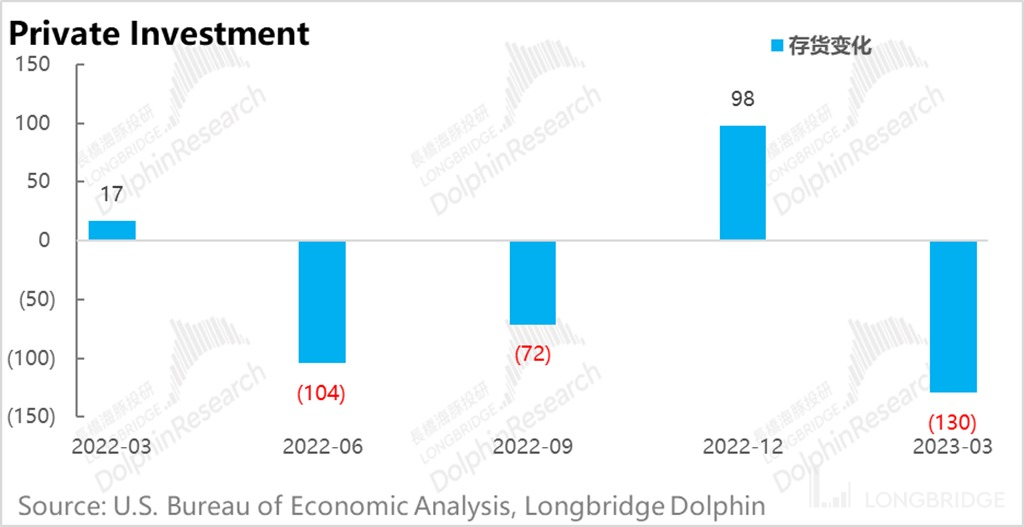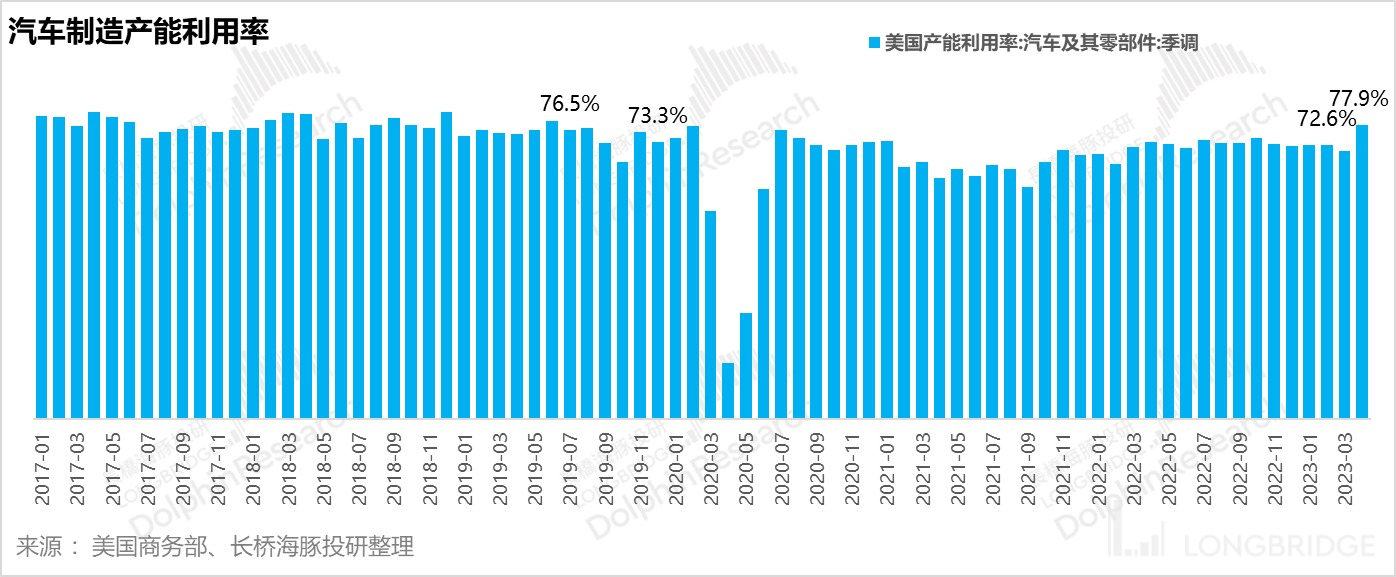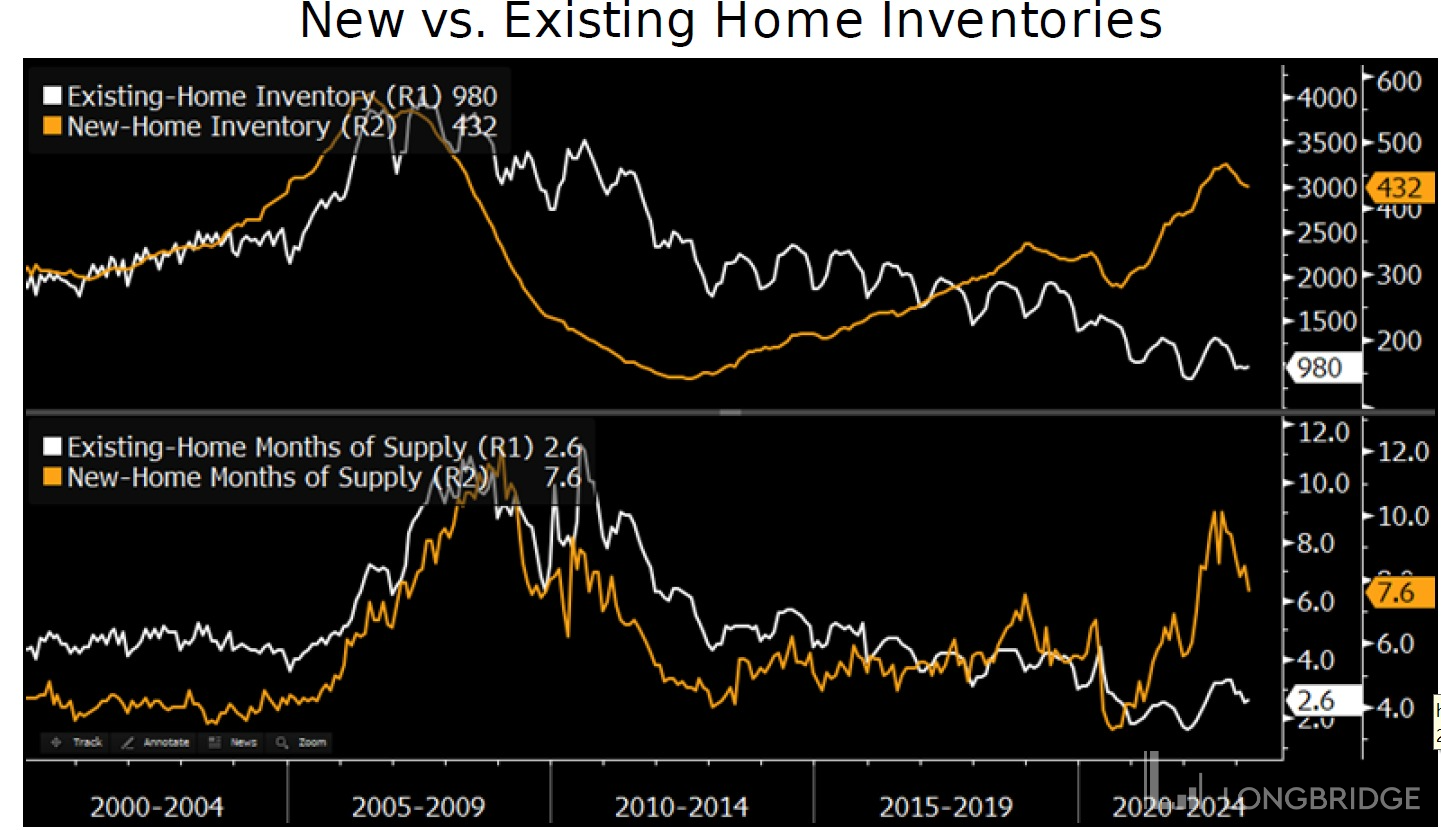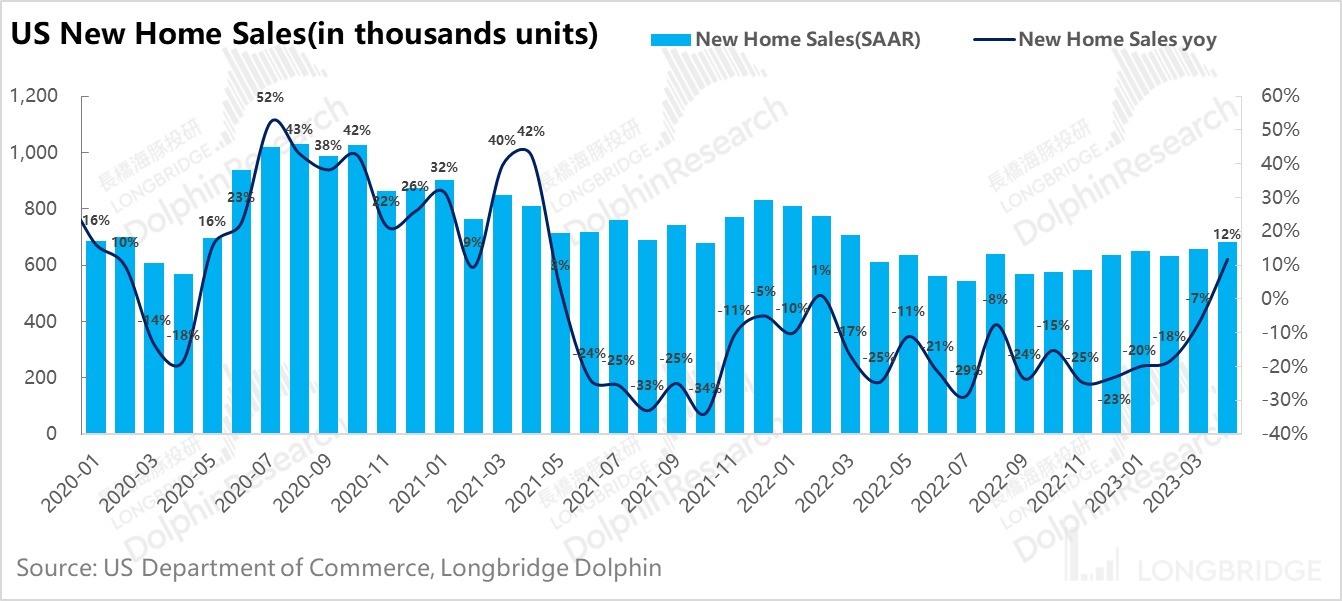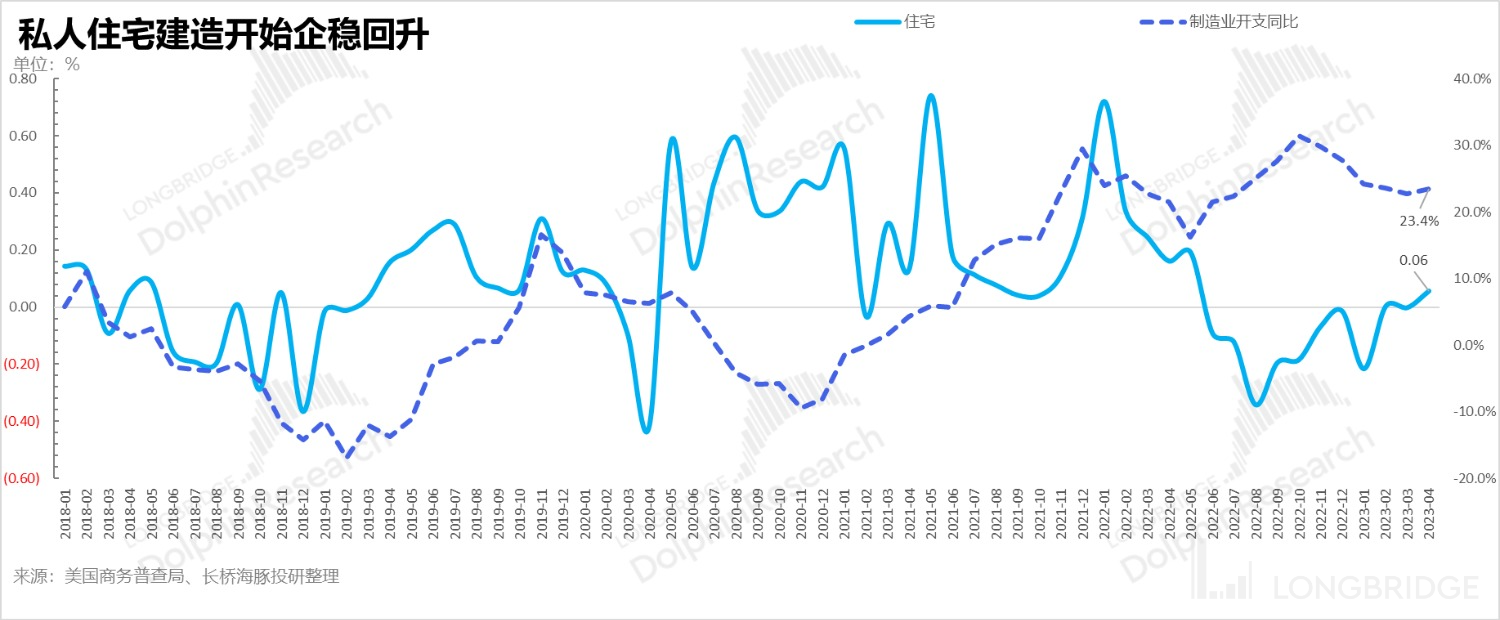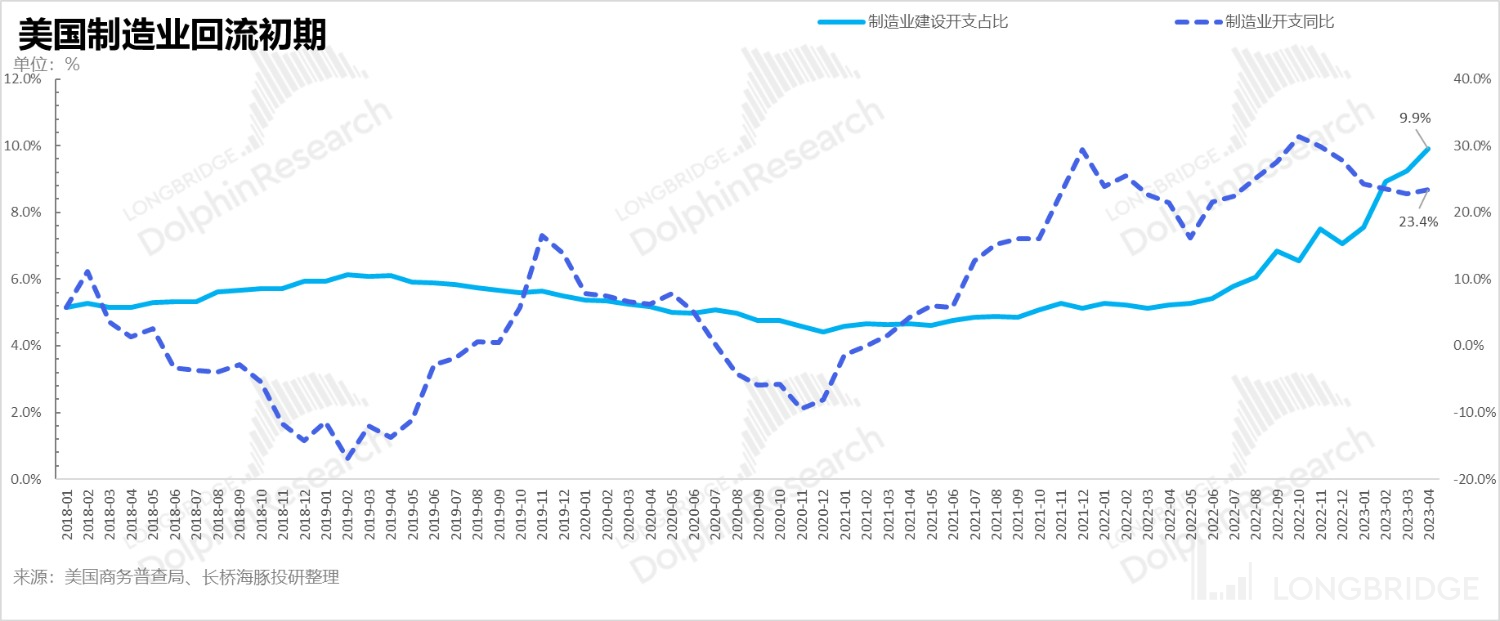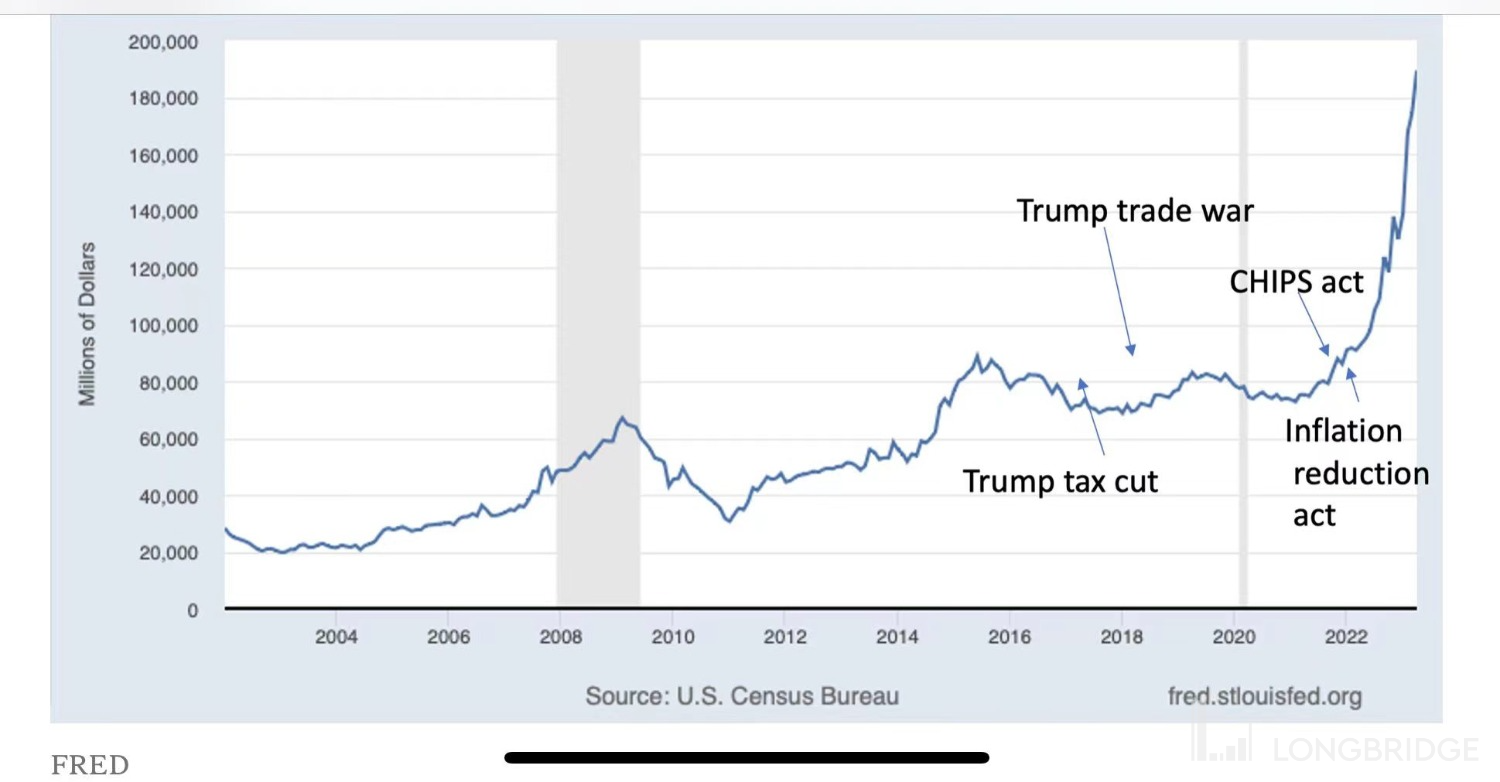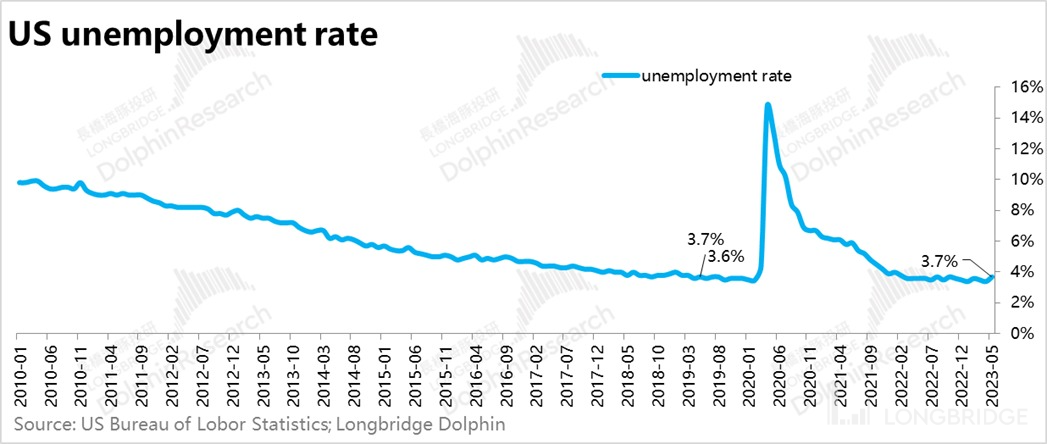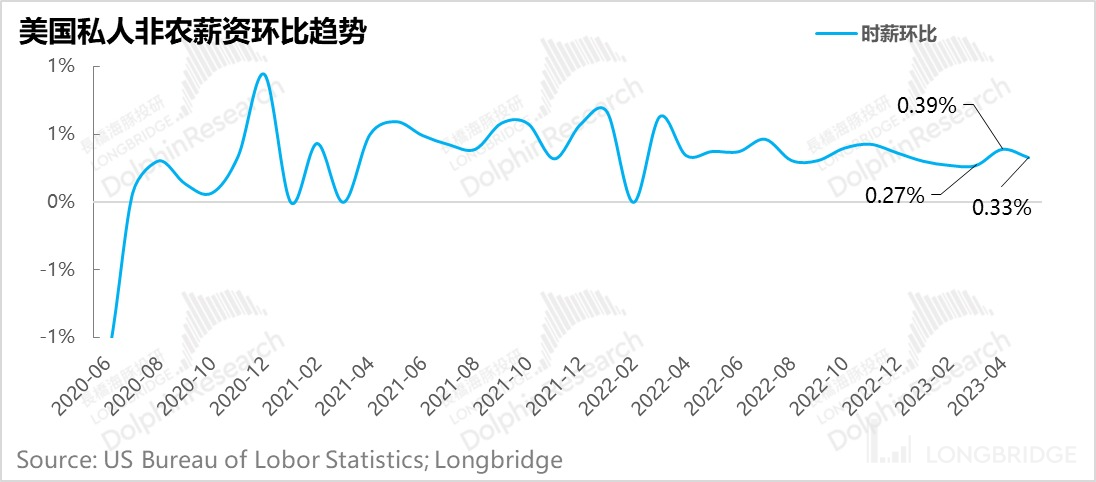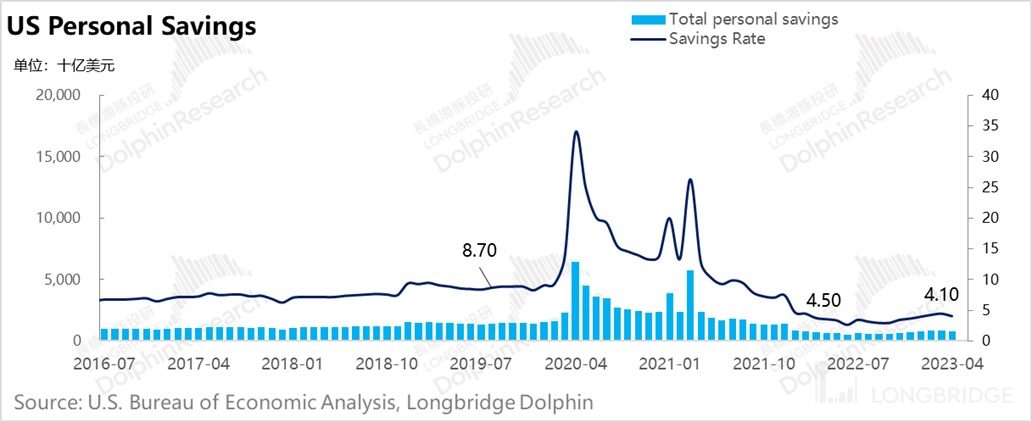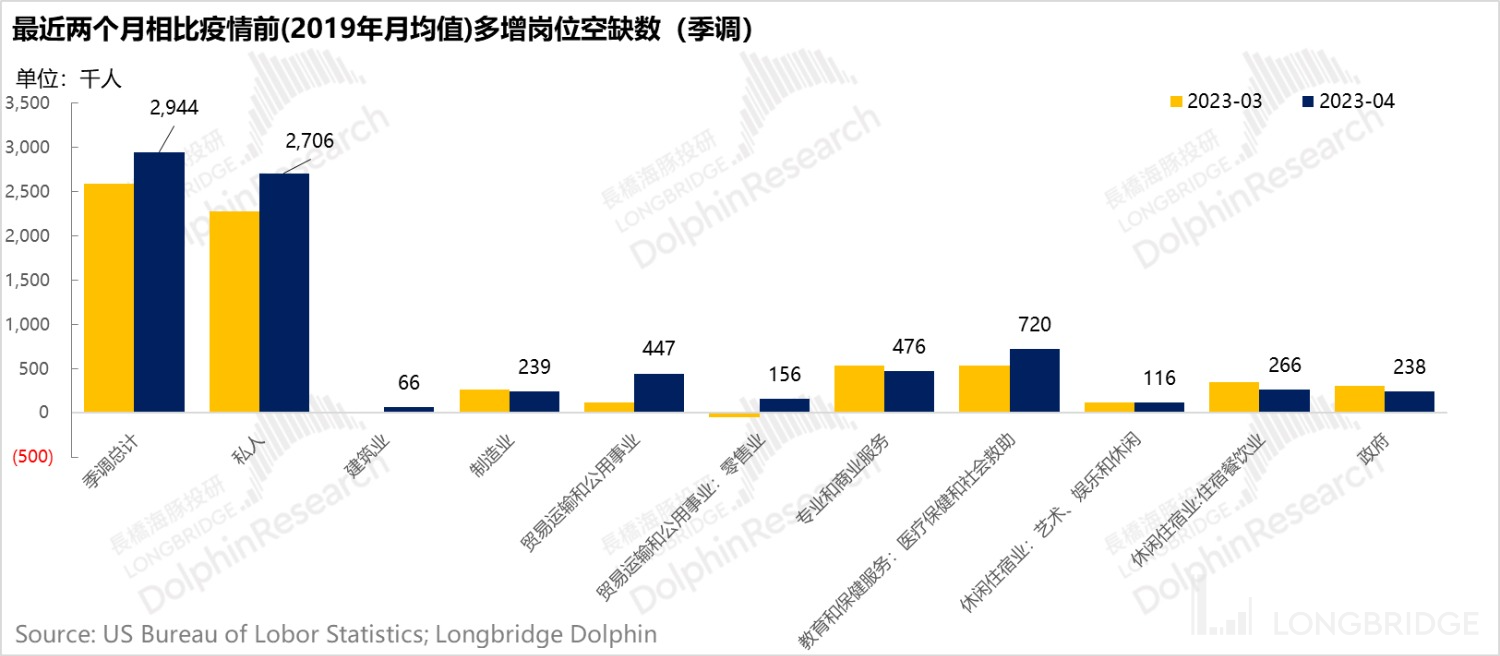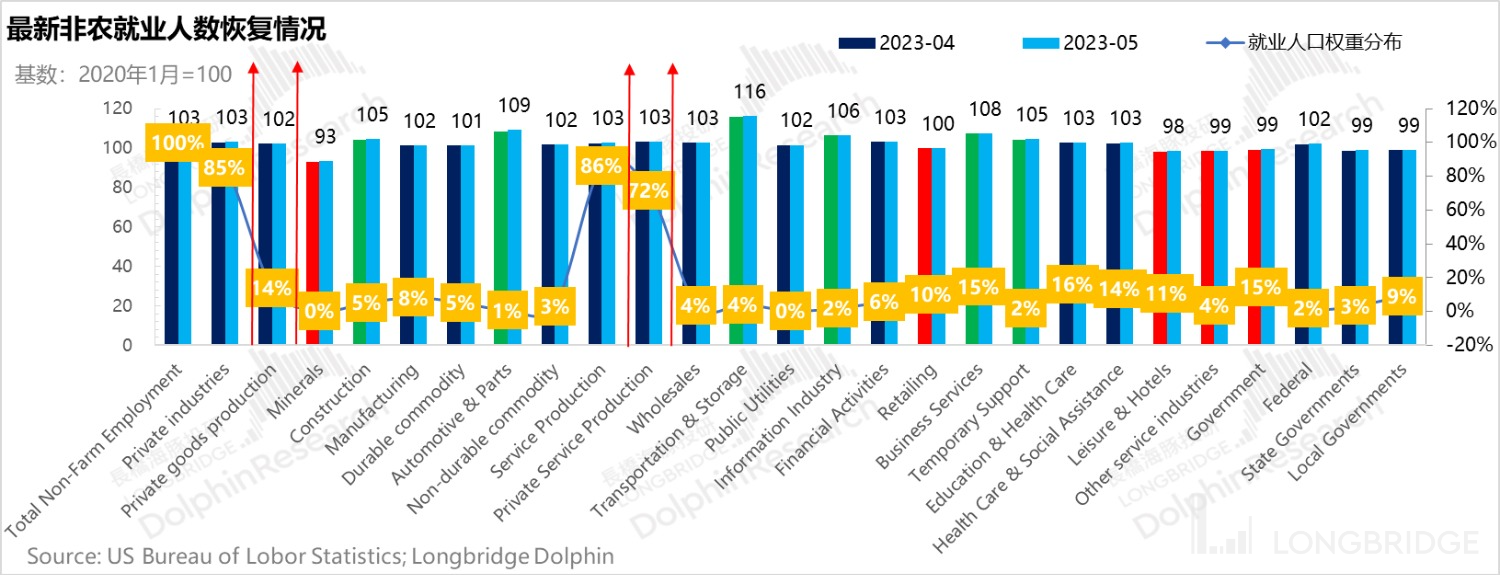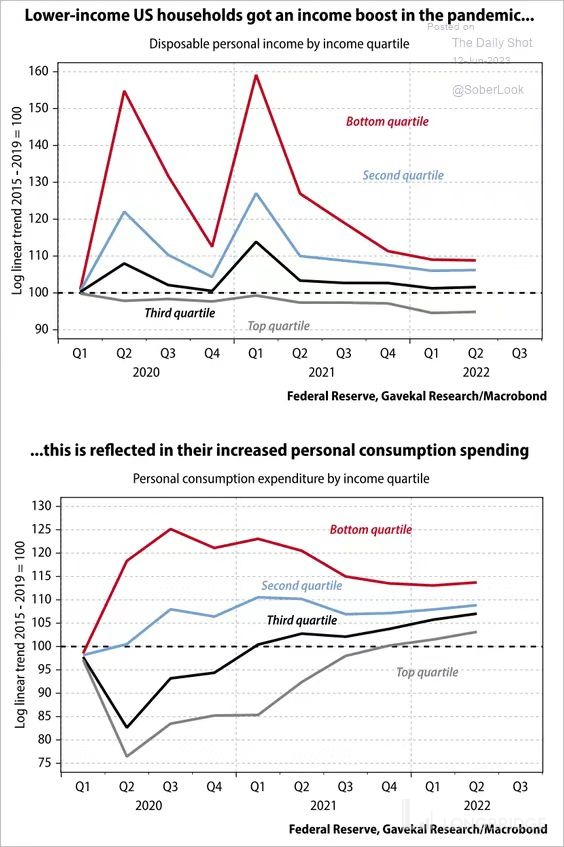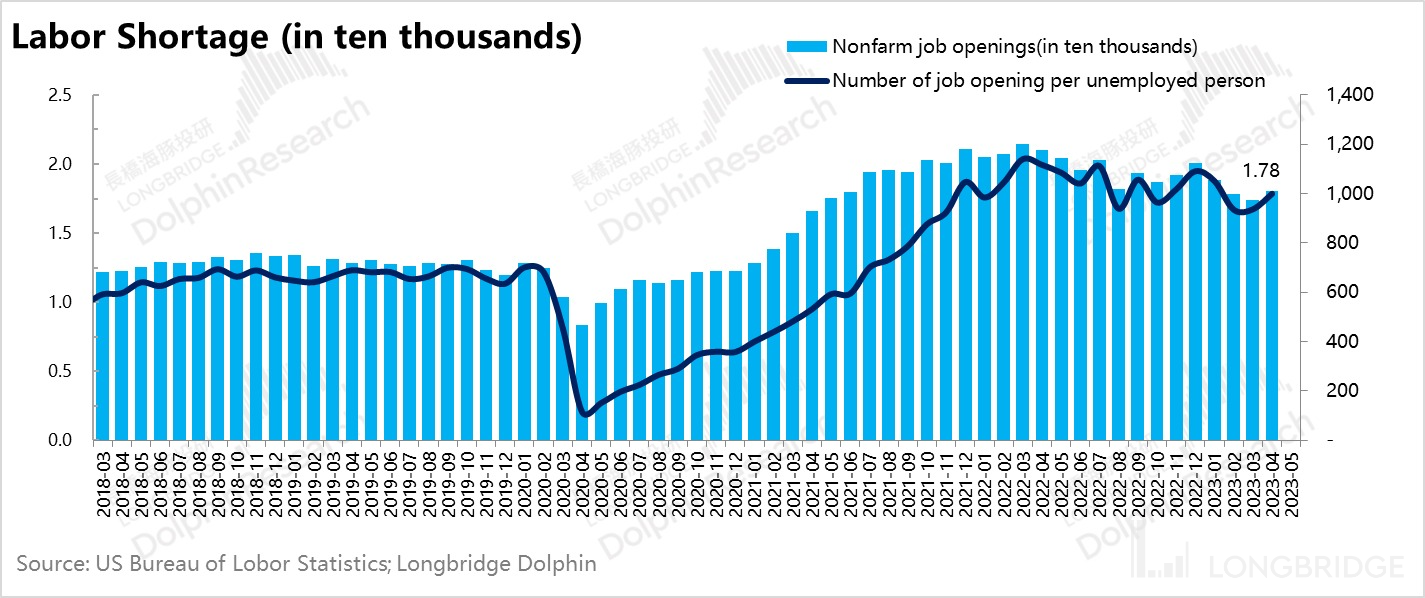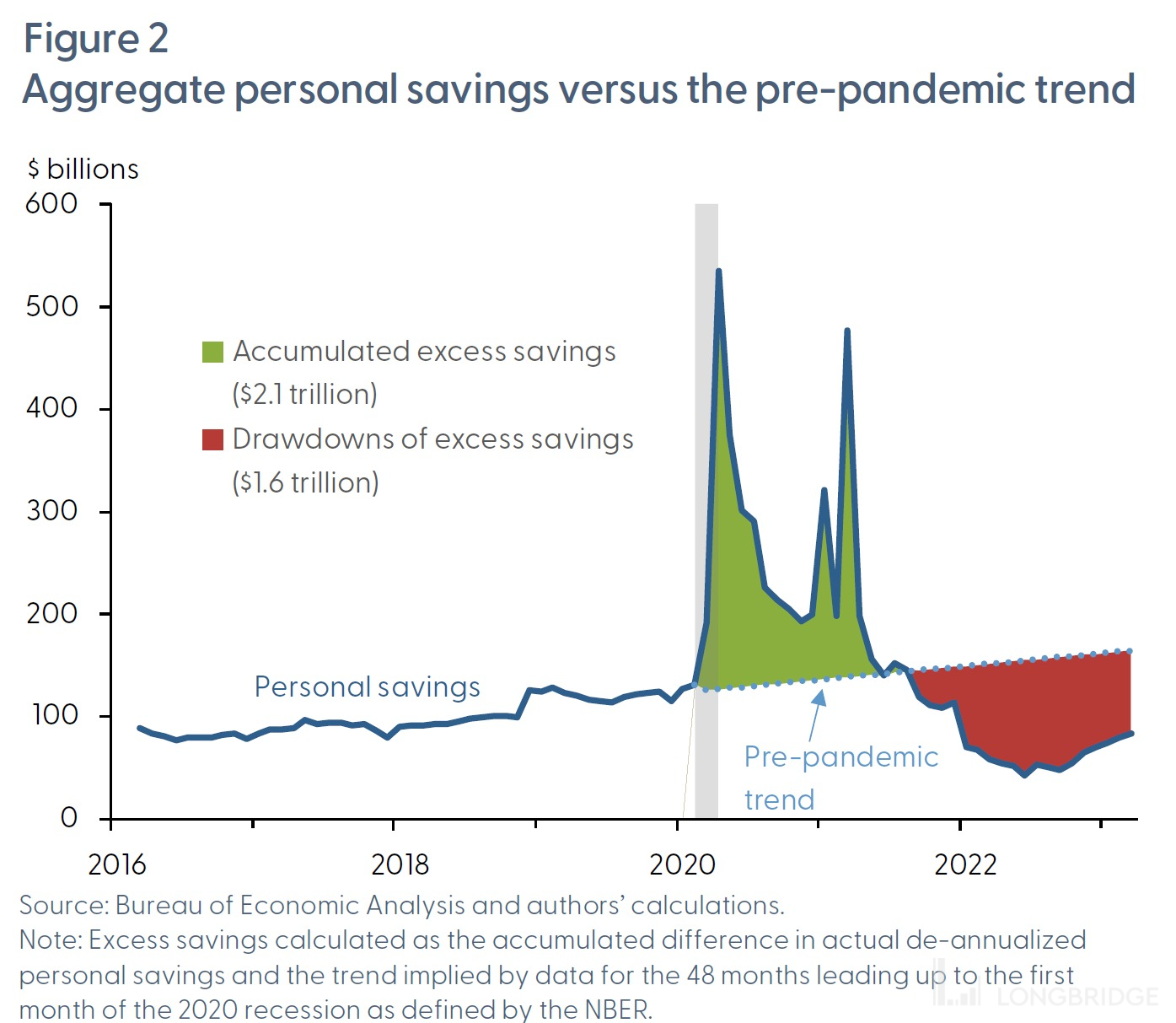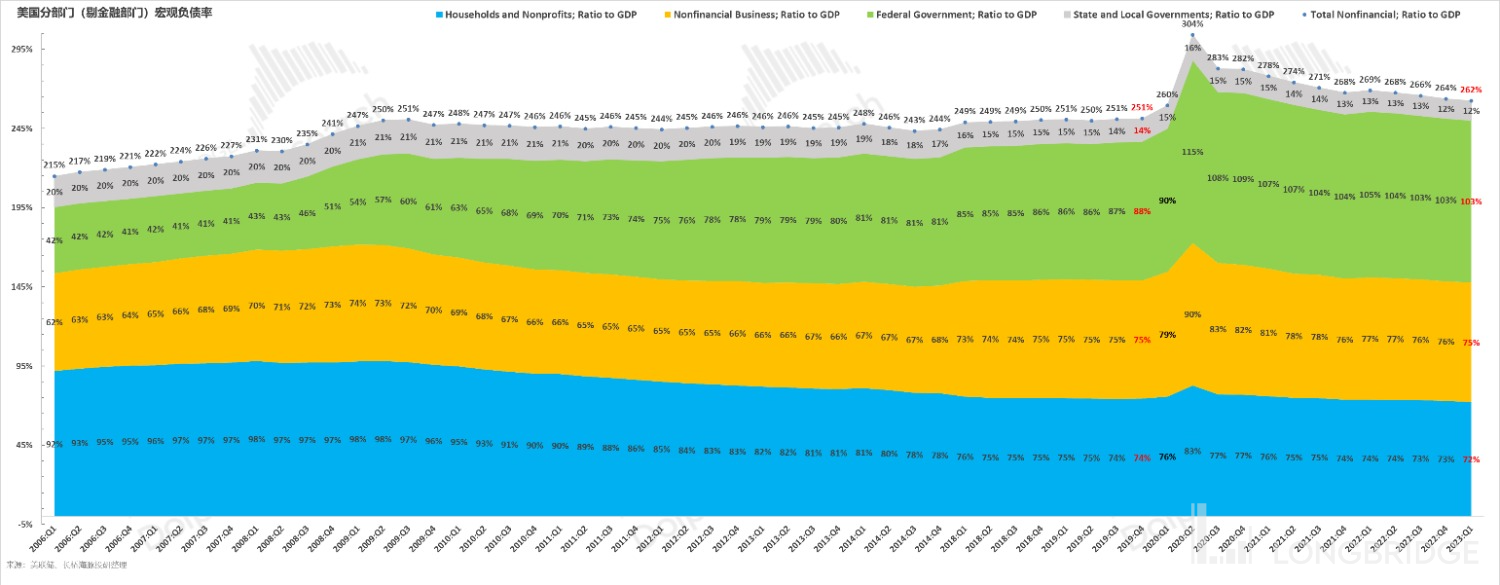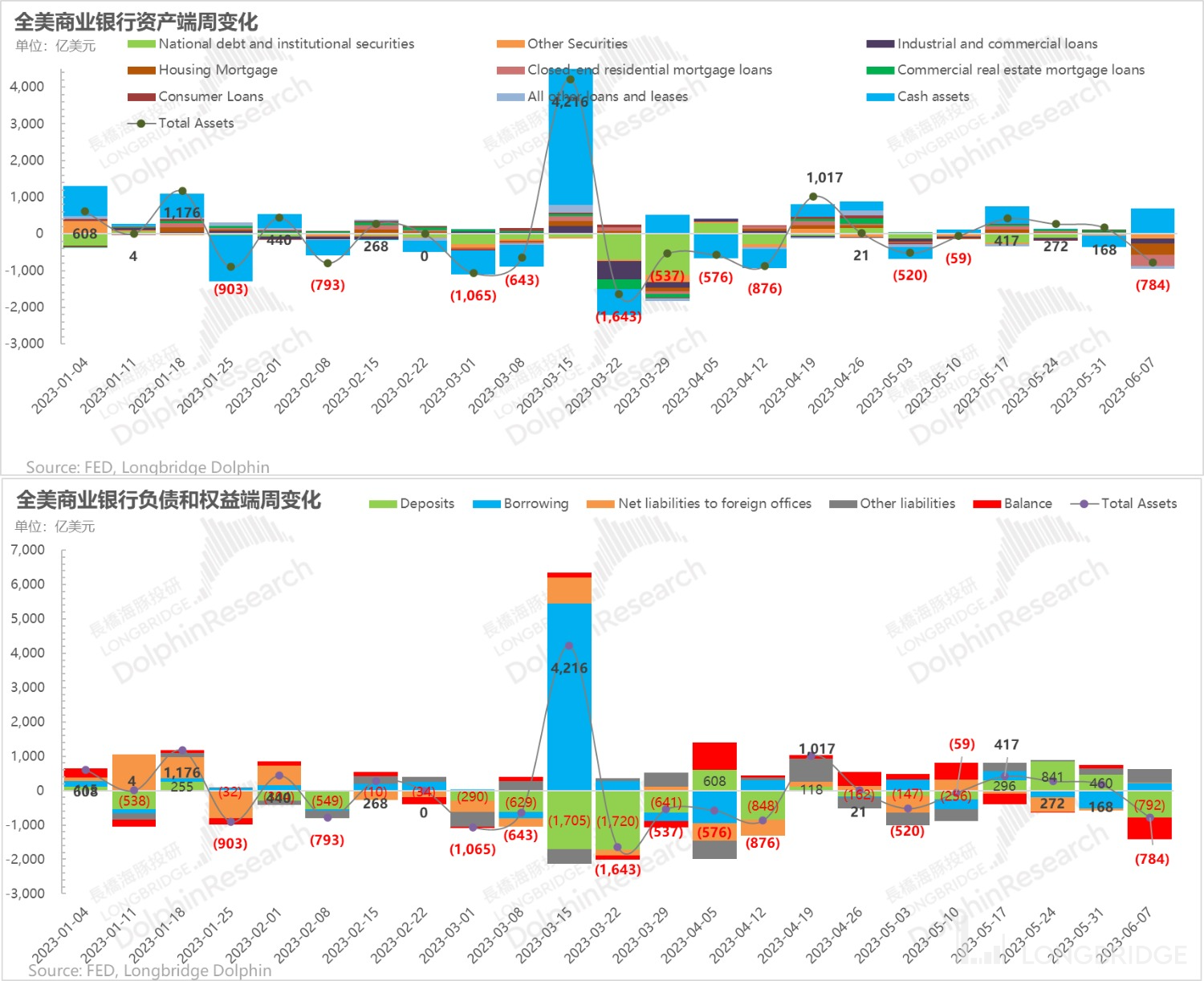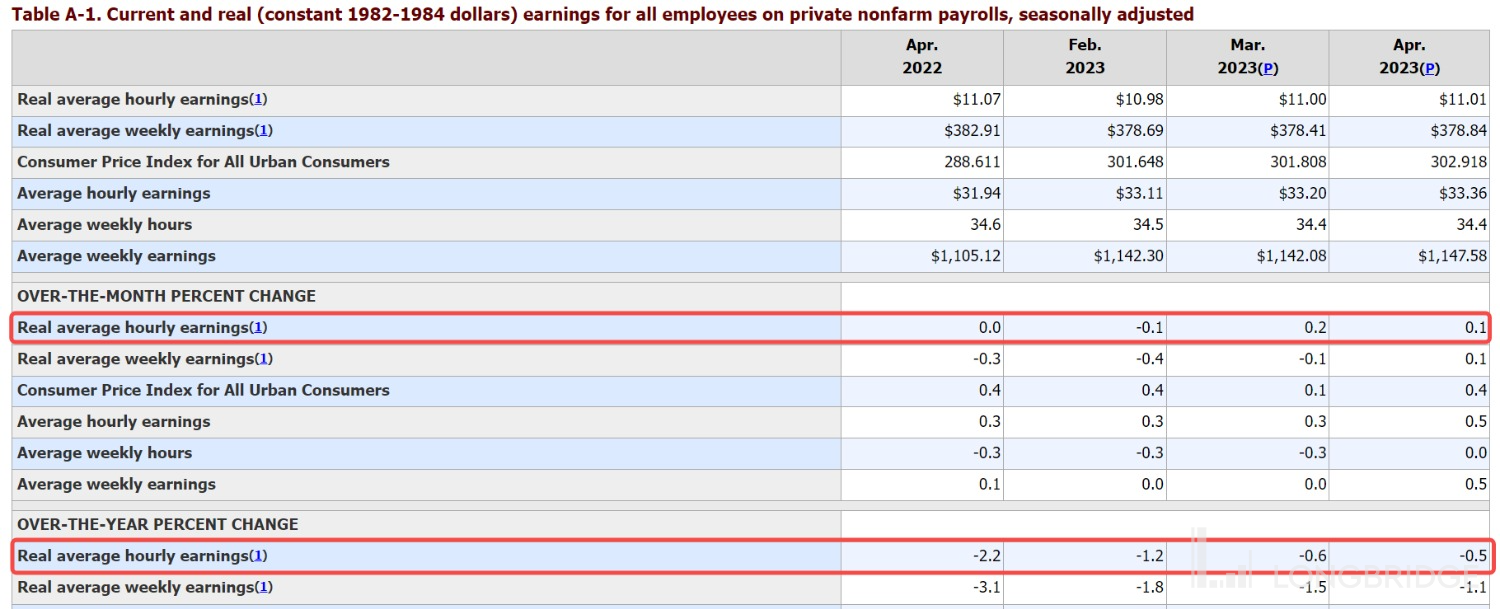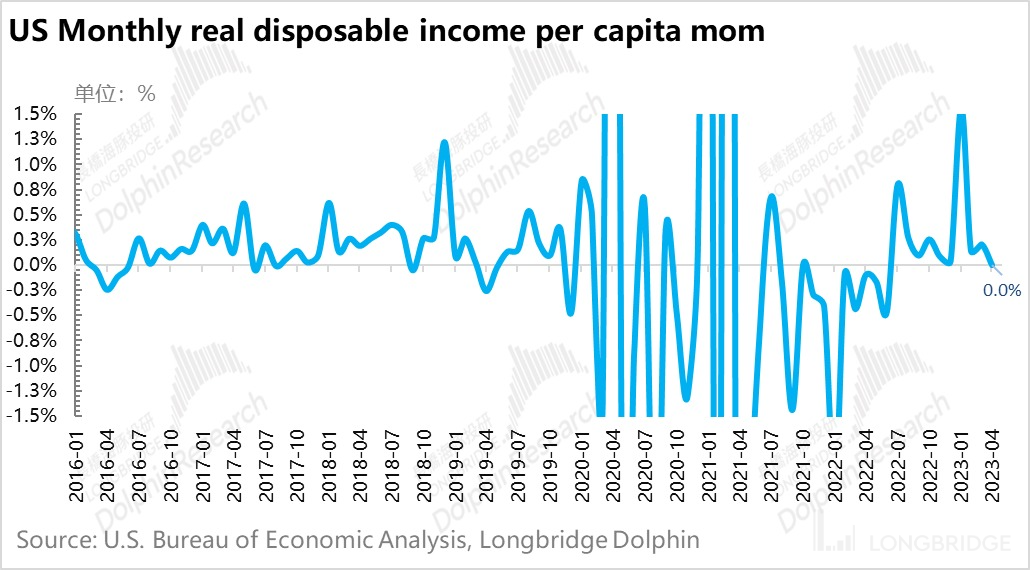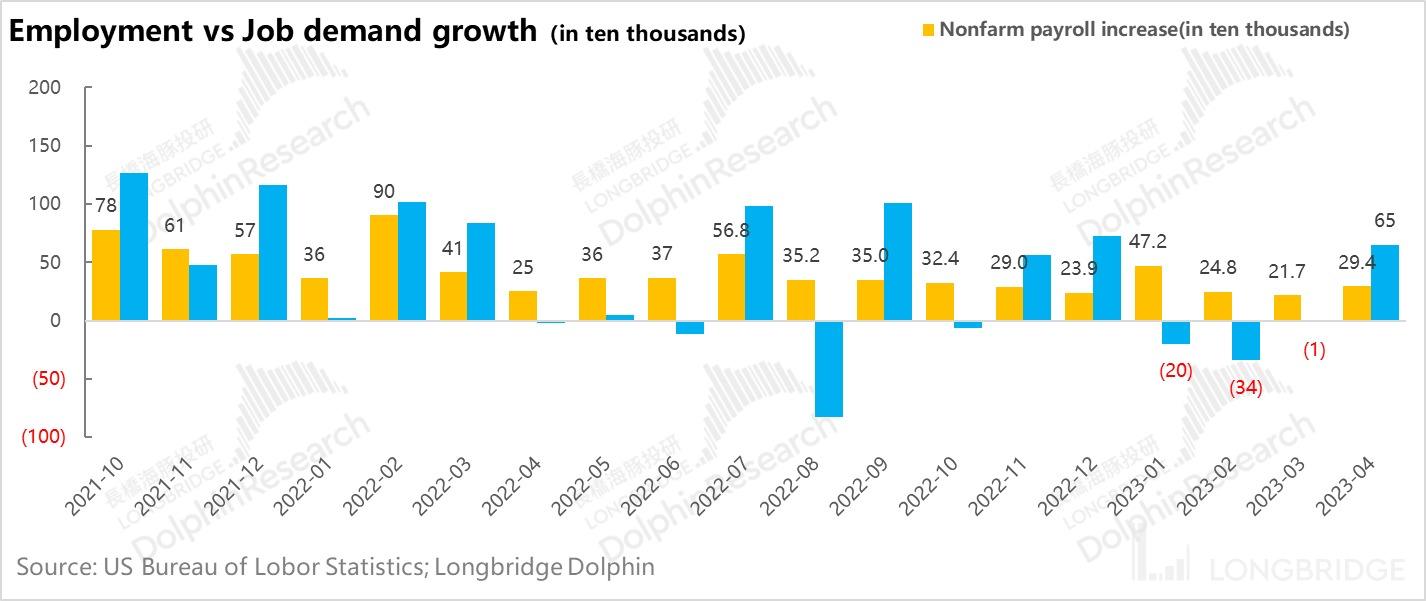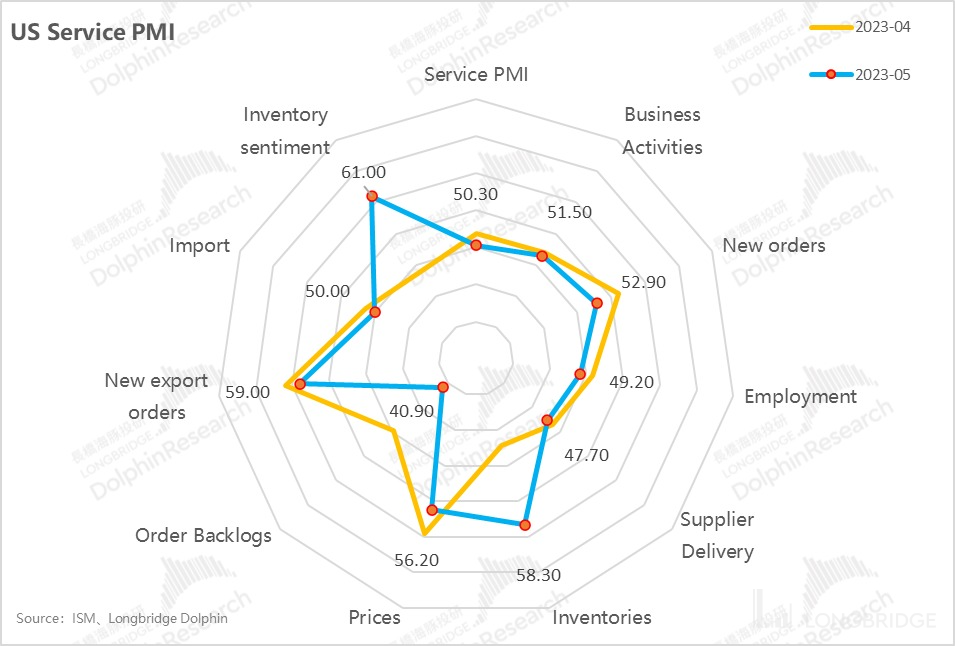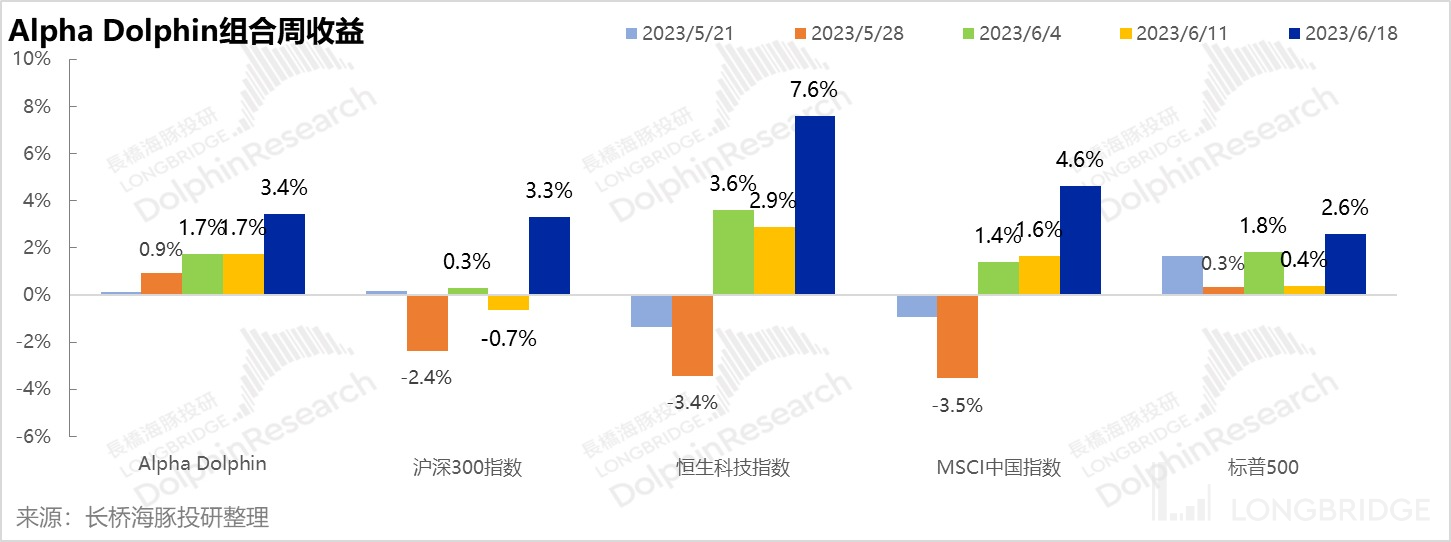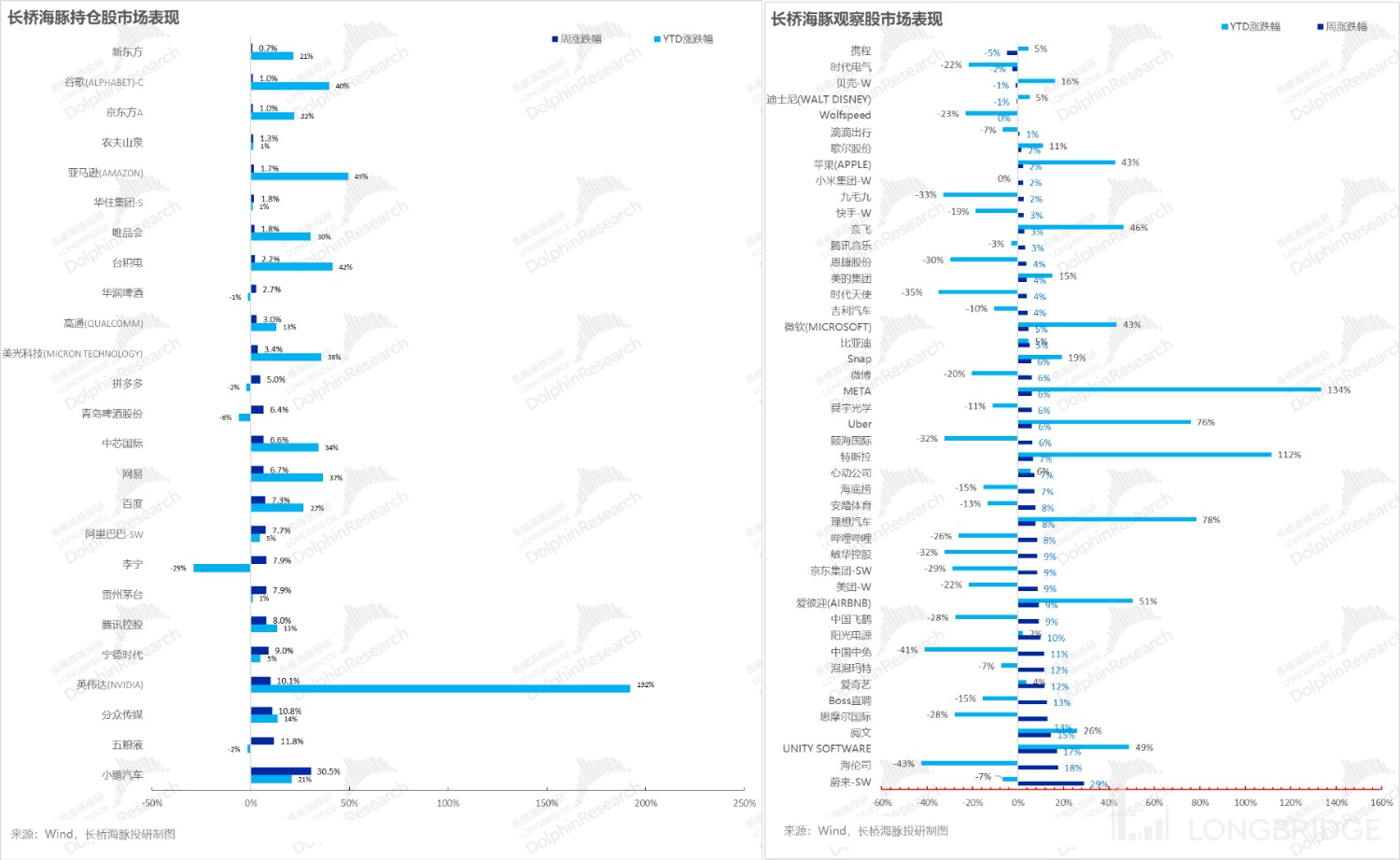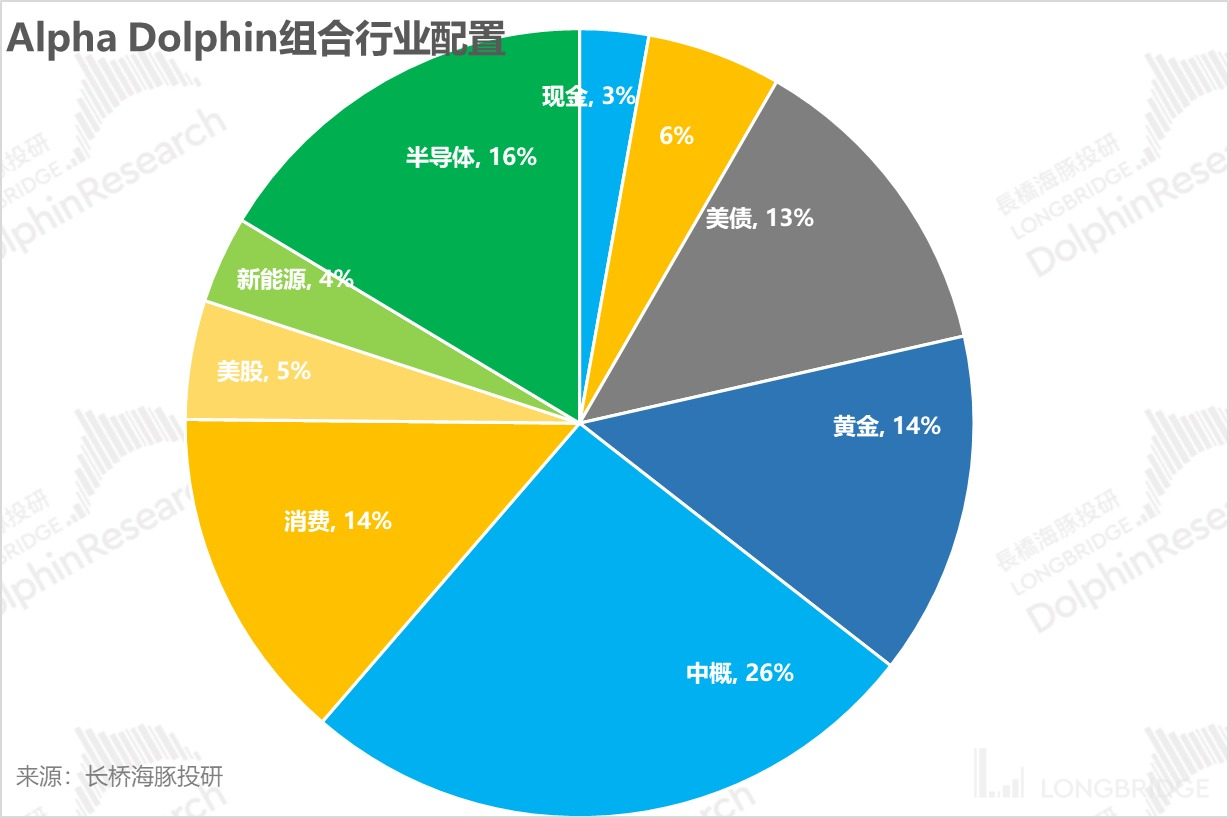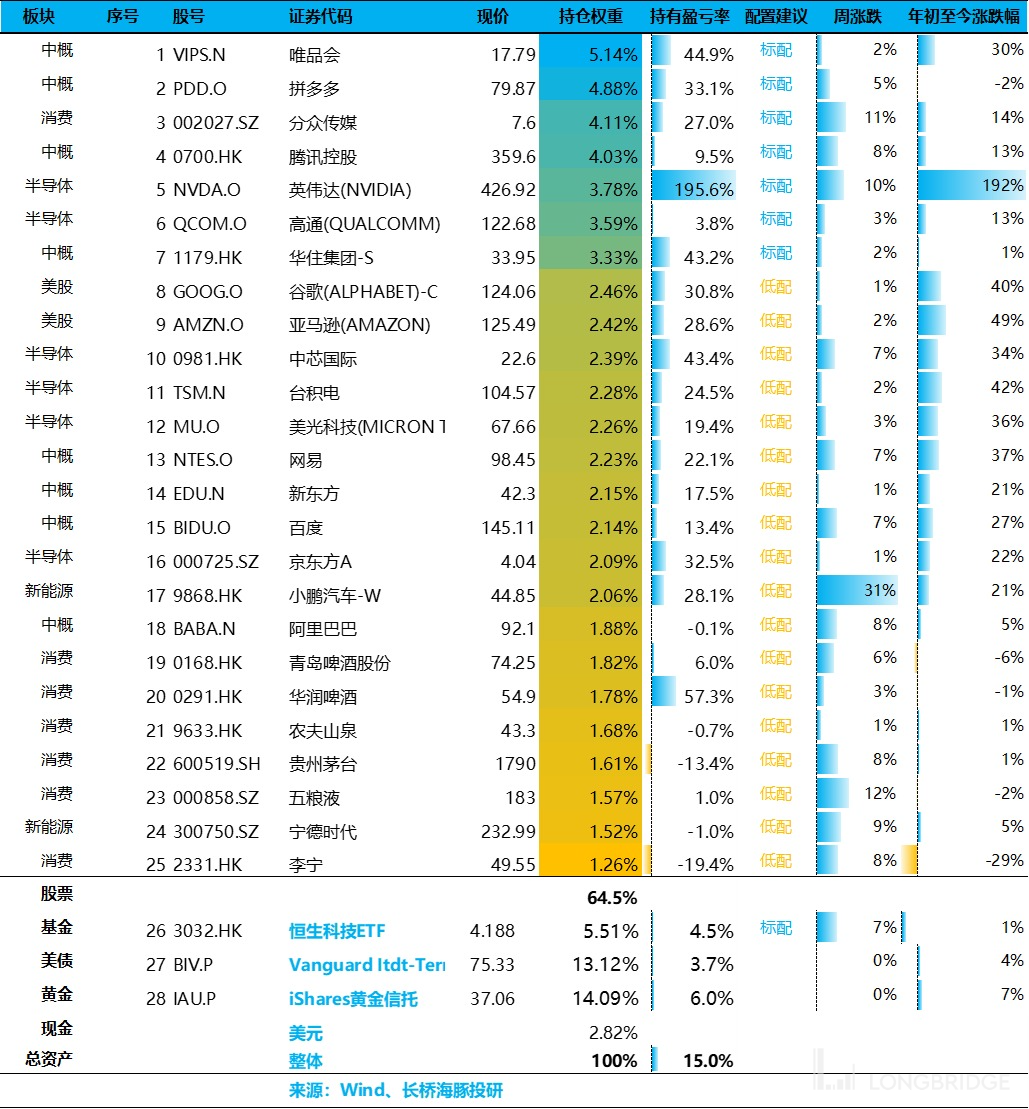Unraveling the Mystery: Where did the predicted US recession go? Will it still come?
In the expected recession path at the beginning of this year, high interest rates affect Americans' spending on large optional items such as houses and cars, and the suspension of home buying demand will have a series of impacts on upstream construction, midstream building materials, downstream real estate brokers, home appliances, furniture, and so on.
After these industries' unemployment fills the gap in the service industry, the employment gap is quickly balanced, and there is no employment contradiction. The GDP driven by cash flow has no driving force to move forward.
But until now, this expected path has not occurred. So why hasn't the recession happened? Only by understanding why the market's forecast for the first half of the year was wrong can we better predict what may happen next.
Therefore, in this article, the Dolphin will dig deep into the core dimensions that drive US GDP growth.
I. Why hasn't the US recession landed?
We know that the US is a typical domestic demand-driven economy, and external demand is a negative contribution, only an extension of domestic demand. The real driving force comes from residents' consumption and investment (buying houses); and corporate investment (adding inventory, hiring people, expanding factories, etc.). Government investment and consumption are only a reflection of countercyclical regulation. If government investment and consumption go up, it can only indicate that the economic cycle is not good.
The Dolphin will focus on residential demand, corporate demand, and government roles to see what special features this wave of the US economic cycle has. Let's start with corporate demand.

1.1) Corporate demand: Little inventory of houses and garages, and manufacturing is returning strongly
In summary, under the magic of supply shutdown and helicopter money resonance, the pressure on large commodity inventory is not great.
Corporate demand is divided into two parts: adding inventory, building factories/buying equipment, and hiring people. From this wave of economic cycles, companies are indeed clearing inventory, especially manufacturing companies, which have been clearing inventory for some time.


a) "Alternative" car inventory cycle
However, the largest category of manufacturing, automobile manufacturing, is not under great inventory pressure this time: the epidemic has seriously affected the supply chain of the automobile manufacturing industry, and the continuous shortage of chips has kept the capacity utilization rate of automobile manufacturing in a relatively low position (the utilization rate of the US automobile industry in 2019 before the epidemic was 75%, which was already in a state of overcapacity in the previous two years. In 2022 after the epidemic, it is 72%).
 If the monthly production and end-of-month inventory of American cars are added together and divided by the monthly sales of American cars, it can be seen more clearly how low the inventory level of the American car industry is in this cycle:
If the monthly production and end-of-month inventory of American cars are added together and divided by the monthly sales of American cars, it can be seen more clearly how low the inventory level of the American car industry is in this cycle:
Before the epidemic, the monthly production and inventory of American cars could basically support the sales of American cars for two and a half months, or even three months. However, after the residents' consumption resumed after the epidemic, the shortage of chips caused the production to continue to rise, and the accumulated inventory before the epidemic continued to be refined. By April 2023, the inventory of American cars can only support one and a half months of sales, far lower than before the epidemic.

b) "Alternative" real estate inventory cycle

In the recession expectation path at the beginning of the year, there is a question about which industry the rise in unemployment rate comes from? The general answer in the market is manufacturing and construction. Because of the decline in commodity consumption, high interest rates affect real estate consumption, driving unemployment upstream and downstream of the entire real estate industry (upstream construction, building materials; midstream real estate brokers, downstream furniture and home appliances, etc., but currently building materials are beginning to recover, and the most important construction industry has not lost jobs.)
The real estate inventory clearance in the past ten years has been relatively thorough: In the residential market, after the subprime mortgage crisis in 2008, the overall US housing market has been in a destocking state, and relatively few new houses have been put into the market. By 2023, new home sales will only account for about 11% of home transactions (China accounts for about 50-70%);

In this interest rate cycle, the US interest rate is rising from low to high. For many landlords, selling and buying houses means that they have to exchange the originally super low interest rate for a relatively high interest rate, so they are unwilling to sell houses. The number of second-hand houses listed for sale is relatively small, and the inventory turnover cycle of second-hand houses is currently only three months, which is lower than the four months before the epidemic.

In the case of few choices for second-hand houses, residents, especially immigrants after the epidemic, are gradually coming in. If there is a rigid demand for buying a house, they will be forced to look at new houses, which leads to the slow turnover of the new house market under this high interest rate. In April, new home sales and private residential construction spending stabilized and rebounded.

 c) Reshoring of Manufacturing: What Trump failed to achieve with tax cuts, Biden accomplished with rough subsidies.
c) Reshoring of Manufacturing: What Trump failed to achieve with tax cuts, Biden accomplished with rough subsidies.
Although the automotive and real estate industries have little inventory pressure, they still affect the entire manufacturing industry on the real estate industry chain. In addition, the digital industry has experienced overheated consumption during the epidemic, followed by a shift to cold consumption, which corresponds to the overall destocking of the manufacturing industry and the reduction of production capacity (if the factory is not closed, at least no more factories will be built).
However, this wave of manufacturing reflects a downward trend (weak commodity consumption), a middle trend (surplus wholesale inventory), and an upward trend (reduction of manufacturing inventory investment), but the source-the overall manufacturing industry is in the initial stage of expanding production capacity-building factories and bringing excess employment resilience to the construction industry. This corresponds to the rebounding private investment in GDP composition (Structures).

The annualized YoY of US manufacturing construction spending in April has doubled: the investment in the early construction of manufacturing plants is exceptionally fierce. From the accelerated pace of building factories in the manufacturing industry, it basically corresponds to the promulgation of the two major bills in the United States: Biden's anti-inflation bill and chip bill.

Summary of Enterprise Demand: The resonance of the above three points a)-c) is that the market originally thought that the sluggish real estate purchase would affect construction employment, and the sluggish commodity consumption would affect the expansion of manufacturing demand for reproduction, and it would also suppress employment in the construction industry.
However, due to low inventory of key large items + industrial policy stimulus + technological cycle, although the United States has sluggish commodity consumption, the overall pressure on the manufacturing industry is not as great as imagined, and the low inventory of real estate + reshoring of manufacturing has allowed the construction industry to have a very cyclical resilience in this economic cycle. The United States did not experience a significant decline in the construction industry during the decline in commodity consumption.
1.2) Resident Demand: Full Employment + Excess Sense of Security Brought by Excess Reserves
As a demand-driven economy, commodity consumption from the resident sector contributes 28% to US GDP, and service consumption contributes 44% to GDP. It can be said that the consumption ability and willingness of residents are the largest economic fundamentals in the United States, and the ability of residents to create income and their expectations for the future are very important for economic growth.
First, let's look at the residents' ability to create income: wage income accounts for 62% of residents' income. In the current situation where transfer income is no longer increasing, wage income is already the largest fundamental aspect of residents' income creation ability and is a key support for residents' purchasing power. From the two dimensions of purchasing power, the number of employed persons (labor force) and hourly wage (labor price) can be separated:
a.) Full Employment:
This wave of natural disasters + strict immigration policies before the epidemic has made the employment contradiction in the United States extremely serious. The latest unemployment rate is only 3.7%, close to full employment status. This is the result of the transfer of other employed populations to non-agricultural employed populations after the slowdown in food prices and the income of self-employed individual businesses.

As for labor prices, the hourly wage has increased by 0.33% MoM, corresponding to a 4% YoY increase after annualization. The nominal hourly wage is growing at a rate that is within the expectations of the Federal Reserve, implying that residents' long-term inflation expectations are anchored.

b) Consumer willingness:
The market originally expected that after excess savings were exhausted and employment positions were quickly filled, the increase in the unemployment rate would lead to a return to pre-pandemic savings levels, which would squeeze consumption. However, after the savings rate rebounded to March levels, it turned downward and stabilized at around 4%, which is lower than the pre-pandemic level of 8.7%, and the expected path did not change.

Dolphin estimates that the reasons for this are as follows:
i: Increased consumption release from fully employed low-income and blue-collar groups
Although home consumption was unusually strong during the pandemic, the weight of service consumption in the United States has continued to recover, and by April, it had risen above the long-term trend.

ii) The increase in the proportion of service consumption means greater employment release, because in the US non-farm employment population, the service industry relies mostly on human labor to fulfill contracts, and machines are much less involved in comparison to commodity manufacturing, making it the main force for employment (absorbing 72% of non-farm employment). After the pandemic, the industries that truly saw an increase in employment were: a. Commodity production: construction;
b. Service production: logistics and warehousing (essential during the pandemic, including the last mile, etc.); medical and social assistance (essential after the pandemic, with a large gap); professional and business services for white-collar workers - accounting, taxation; construction, engineering design, and temporary support blue-collar positions.


Blue-collar workers, whose overall savings rate is lower, can bring more consumption release through their full-time additional employment, thus structurally lowering the savings rate.

iii: Sense of Security Increases: No Worries About Finding Work
Due to the relatively high demand for labor in the service industry, the increase in the proportion of service consumption will release employment opportunities to a greater extent. The shortage of labor has led to prominent employment contradictions. In the market, one unemployed person corresponds to two positions that need to be filled. In this situation, there is no need to worry about losing one's job, and there is a strong sense of security. The desire to save money is also relatively low.

iiii: Excess Savings Have Not Been "Spent" Yet
According to statistics from the research institution of the Federal Reserve, there is an excess savings of 2.1 trillion US dollars, and there will still be 500 billion US dollars left by March 2023. The monthly consumption rate is about 50-80 billion US dollars. The support of excess savings for consumption can continue until the end of 2023.

c) Strong Consumption? It's Only Natural
Speaking of which, we can understand why the retail sales data released last week showed that Americans are still buying and consuming. Specifically:
Following the oversupply of non-agricultural employment of 339,000 people in May and the MoM hourly wage growth of 0.33% (YoY growth of 4% after annualization), the second most important data in May, the US retail sales data, was also released, with a MoM growth of 0.34%, which is basically consistent with the nominal hourly wage growth rate.
This once again verifies that under the overall low household debt ratio and the situation of "high interest rate" pressure, the current US economy is basically a "cash flow" type GDP: the low savings rate has stabilized, and the release of consumption is mainly driven by the marginal increment of social employment population and hourly wage.

Looking at the sub-items, there are two changes that are almost "doubtful about life": the two largest items, cars and houses, which were mainly suppressed by the high interest rate environment, but from the May retail sales data, it seems that this is not the case.
a.) Motorcycles and Parts: As the largest single category accounting for 19% of retail sales, car consumption seems to have returned in April after hitting bottom in February and March. In May, the seasonally adjusted retail sales of cars further accelerated, with a MoM growth rate of 1.38% (YoY growth rate of nearly 18% after annualization), which is very exaggerated. Elon Musk's previous statement that high interest rates are suppressing car purchases is not obvious. b.) Building materials and gardening consumption rebound: This type of consumption is theoretically downstream of real estate transactions. With the sluggish sales of new homes, this type of post-cycle real estate consumption should be the most depressed. However, after the MoM growth bottomed out in March, building materials consumption seems to have returned by May. Even furniture and home decoration have recovered to a MoM growth rate of 0.39% in May.
Summary of resident demand: The pandemic disaster (people begin to pay more attention to health and spiritual consumption?) + the government's water release operation has brought about the effect of robbing the rich to help the poor. From the perspective of employment, it has harvested white-collar workers and made blue-collar employment more sufficient, narrowed the income gap, and increased the consumption rate. GDP growth is still strong after the epidemic.

3.) "Tangible Hand"
a. Large-scale acquisition
The US government has taken over all the additional debt of residents and enterprises caused by the epidemic's non-production, and added it to the federal government. After the epidemic, residents' balance sheets performed the best, followed by enterprises, and the worst was the federal government. Moreover, residents' cash flow is also relatively good due to excess savings, which has triggered a "spending spree" mode.

b) Is the strong US dollar and high leverage a problem?
i. Treasury bonds, as the toxic assets of this economic crisis, are reflected in bank balance sheets: small and medium-sized banks are in crisis and have already been backed by the Federal Reserve.
The remaining problem is the outflow of high-interest resident deposits. Although the problem of resident deposit outflow from the banking system has reappeared after the solution of the national debt ceiling, looking at the weekly fluctuations, the US banking system has not seen a "large-scale deposit run."

ii) The national debt ceiling problem has been solved, and its main function is to reduce the fiscal budget of the Democratic Party government, and it has not restricted the Democratic Party government's policies on manufacturing industry reshoring (investment in new energy and semiconductor). The main control is the expenditure of taxes.
Second, is it perfect to get out of the pit? Is it flawless?
From the above, it seems that during this special period of the epidemic, after the United States used unlimited government credit to backstop, the actual economic problems have been perfectly resolved. So far, there is no sign of economic decline in the United States. Under high inflation and high interest rates, with high growth, has the US economy adapted to the high-interest environment?
However, Dolphin believes that although the US government's high leverage can use the US dollar's status and open the US debt ceiling to solve the problem, the resident sector has actually been damaged so far: per capita real purchasing power. 2.1) Quietly Eroded Purchasing Power
As can be seen from the chart below, the real hourly wage after non-farm inflation has not truly recovered either YoY or MoM, and is not as resilient as GDP performance suggests. Moreover, from the perspective of real per capita disposable income, there was zero growth MoM in April, while core CPI in May increased positively by 0.4% MoM. The MoM growth rate of nominal hourly wages was only 0.33%, and the real purchasing power of residents is still being eroded.
This means that if the current situation continues, due to long-term inflation expectations anchoring, the real per capita purchasing power of residents is actually the one that is truly hurt.
The reason why the market currently does not feel this is mainly because the residents' asset-liability ratio is good, and there is excess savings. In terms of the dimension of the total purchasing power of residents, the contradiction between employment supply and demand is still relatively large, and employment is relatively sufficient. From a total perspective, the problem of the real per capita purchasing power of residents being eroded cannot be felt.


2.2) So where will the turning point of the US economic downturn come from?
Driven by cash flow, retail and consumption data are lagging indicators. When current income dominates the economic growth expectation, Dolphin believes that the following changes are more critical, which is the indication of the US economic downturn:
a) Pay attention to the turning point of excess savings: most institutions point to the end of this year or early next year when it will be spent.
b) Pay attention to the turning point of the job market: what needs to be seen is the turning point of the market contradiction. Currently, the job market is still hot, and the job market is in a high flow state.

c) Turning point of service consumption: The May service PMI has shown signs of cooling down. Subsequently, continue to observe the service PMI to see if it will enter a continuous deterioration state. If it continues to deteriorate, it may mean that the subsequent employment contradiction will become smaller, thereby affecting the overall purchasing power of residents.

3. Implications for Strategies
3.1) US Stocks:
In this case, Dolphin believes that there is still a possibility of recession in the US economy in the future, but this wave is likely to be a "slow-motion" mild recession, that is, a soft landing. In this case, US stocks need to pay attention to cost-effectiveness, but it is not advisable to excessively short US stocks. In the current bullish trend of the US stock market, it is mainly driven by the technology stocks that prevent recession and the technology cycle. If the economy gradually softens in the future, traditional industries in the United States, mainly represented by the Dow Jones Index, will also have opportunities for recovery.

3.2) Chinese Assets:
In the domestic economy, due to the heavy reliance on real estate, the recovery of consumption during the real estate destocking cycle is limited. In terms of external demand, China is good at exporting goods, but the consumption of goods in the United States and Europe is weak. Under the situation of weak domestic and external demand, consumer assets are likely to only stay at a super low rebound and it is difficult to have real upward elasticity. The opportunity for TMT in new industries may be greater than that of consumption this year.
Chinese assets in the past two weeks have been in such a super-depressed rebound. However, when paying attention, chasing after the rebound of super-depressed stocks is much riskier than chasing after the upward space when it truly opens up. After the valuation is repaired to a certain extent, risk control should be paid attention to.
IV. Portfolio Rebalancing
Recently, Dolphin has identified opportunities in Hong Kong stocks and has adjusted a wave of undervalued and fundamentally good individual stocks. Last week, it began to adjust the new energy stocks that are super-depressed and have a certain opportunity to reverse. It also increased the allocation of the index as a whole during this rebound. The details are as follows:

In addition, US technology stocks are beginning to show signs of overgrowth. Before the US stock earnings season arrives, this week, we will moderately reduce the position of technology stocks.
V. Portfolio Returns
In the week of June 16th, Alpha Dolphin's virtual portfolio rose again by 3.4%, outperforming the S&P 500 Index (+2.6%) and basically synchronized with the CSI 300 Index (3.3%), but lagging behind the MSCI China Index (+4.6%) and the Hang Seng Technology Index (+7.6%).

Since the start of the portfolio test until the end of last week, the absolute return of the portfolio was 23.9%, and the excess return compared with the MSCI China was 41% (the original Wind statistical data had some problems, and after updating, the excess return was higher. From the perspective of asset net value, Dolphin's initial virtual assets were USD 100 million, and currently it is USD 125 million, with a net value of 1.25).
 Six, Individual Stock Profit and Loss Contribution
Six, Individual Stock Profit and Loss Contribution
Last week, the portfolio's income mainly came from the previously heavily oversold new energy and consumer stocks. These companies, which have been significantly repaired, had more or less obvious flaws in their fundamentals before, either relying too much on Beta, such as Focus Media and Boss Zhipin, or having problems with the company itself, such as Xiaopeng, Weilai, and Helenbergh. From this perspective, under the relatively weak and unresilient macroeconomic fundamentals of the overall consumption, the valuation repair of Hong Kong stocks has already entered the second half.

The specific reasons for the rise and fall of the companies are summarized by Dolphin as follows:

Seven, Portfolio Asset Distribution
There was no adjustment in the portfolio this week, with a total of 26 stocks or ETFs allocated, of which 8 were rated as standard and 18 were rated as low. The rest were gold, US bonds, and US dollars.
As of the end of last week, Alpha Dolphin's asset allocation and equity asset holding weights were as follows:


Risk Disclosure and Statement for this Article: Dolphin Research Disclaimer and General Disclosure
Please refer to the recent weekly reports of Dolphin Research Portfolio:
"Small composition controls the market? Overcoming extreme pessimism is the core."
"Purgatory vs. Frenzy, what are US stocks and Hong Kong stocks trading?" app_id=longbridge&channel=t6604716&invite-code=276530)
《Don't Despair, Reversal is Coming: US Stocks Pull Valuations, Hong Kong Stocks Kill Beta?》
《Put High Interest Rates in Another Bank? The Chance of a Soft Landing is Even Greater》
《ChatGPT vs Performance List, Can Giants Support US Stocks?》
《The Promised "US Recession, China's Recovery", Is It Going to Fail?》
《The Direction of US Recession is Set, Only a Small Decline is Comforting, a Big Decline is Harmful》
《US Service Consumption Collapses, US Stocks Celebrate?》
《Fed Rate Cut: Just Waiting for the Moment of Attack by the US Version of Yu'ebao?》
《US Stocks Will Recede and Cut Interest Rates? Anyway, Trading Has Already Run Ahead of the Game》
- 硅谷银行挤兑危机:美国衰退要跑步到场?
- 美股回吐完交易抢跑,全球终能喘口气
- 通胀抬头实锤?否极泰来反是机会
- 通胀暂放一边,阿里和百度里的信号更重要
- 港美齐齐弱鸡,狼又要来了?
- 高频宏观的牵线木偶,美股是傀儡市
- 一根阳线改信仰,特斯拉带领美股杀回来了?
- 美股 “危”“机” 变局还有多远
- 美股没有过年红,但业绩锤却近在眼前?
- 扒一扒美股滞涨的根源
- CPI 已经回落,美联储为何还是这么轴? 《Is it really easy to eliminate service inflation? Beware of market overcorrection》
《Has Hong Kong stocks finally got a backbone? Independent market still has room to grow》
《The darkest hour before dawn: the mentality is focused on darkness or dawn》
《 US stocks "hit back" at reality, how long can emerging markets bounce?》
《Global valuation repair? There are still hurdles for performance verification》
《China's asset violence rises, why are China and the United States in two different worlds?》
《Behind the policy shift expectations: unreliable "strong US dollar funds" GDP growth?》
《Slowing down interest rate hikes? The American dream is shattered again》
《 Rethinking a "iron-blooded" Federal Reserve》
《 Sad second quarter: "Eagle sound" is loud, collective crossing is difficult》 《Falling into Doubt, Is There Still Hope for Reversal?》
《The Fed's Violent Hammering of Inflation, and the Opportunity for Domestic Consumption》
《The Fed Becomes the Number One Bear, and the Global Market Collapses》
《The United States Moves Left, China Moves Right, and the Cost-Effectiveness of U.S. Assets Returns》
《The Interest Rate Hike Enters the Second Half, and the "Performance Thunder" Opens》
《China's Current Assets: "No News Is Good News" for U.S. Stocks》 《Is the United States definitely in decline despite the carnival of growth?》
《In 2023, will the United States decline or stagnate?》
《American oil inflation, can China's new energy vehicles become bigger and stronger?》
《The Fed's interest rate hike accelerates, but China's asset opportunities have come》
《The inflation of US stocks has exploded again. How far can the rebound go?》
《This is the most grounded way. Dolphin's investment portfolio is launched》




